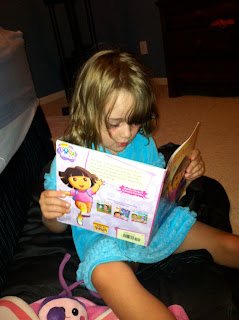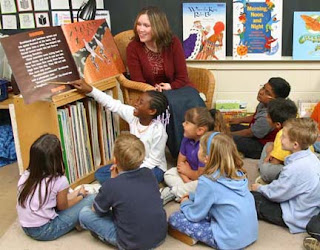For my real-life inquiry project I wanted to see how reading aloud would affect a child’s ability to read the same book. I decided to use my five year old niece for my project. She is entering kindergarten this fall. She is in the beginning stages of reading. She understands how books work (which way to hold the book, which was the pages turn, the text goes from left to right, etc.) and she knows all of her letters. She is just beginning to recognize some high-frequency words.
I decided it would work best if I let my niece choose the book. She chose to read Dora the Explorer: First Day of School. I explained to her that I was going to read the story to her, then we were going to go back through the book and see if she could “help me read it again.” I thought this would be a good strategy to get her engaged in the project because she loves being a little helper.
I read the book to her, pointing at the words as I read. After I finished, we went back to the beginning of the book. I started to read the book again and stopped at different words that I thought she might recognize, in order to allow her to say the word if she knew it. She followed along well and said more words than I expected, but most of the words were the characters’ names. I think environmental print had a lot to do with her recognizing the characters’ names. The “Letting Go of ‘Letter of the Week’” article by Bell and Jarvis discusses the use of environmental print in the classroom. I am not really sure if she actually recognized the text of the other words she said, or if she just remembered the words from hearing this story multiple times. Even if she just remembered the words, I think that is a good way for her to learn them because she can look at the text and know what the word looks like in print. The NAEYC/IRA position statement article states that The single most important activity for building these understandings and skills essential for reading success appears to be reading aloud to children.” I agree with this article. I believe reading aloud to your students is incredibly important and very beneficial to all students.
Madison's Reading Blog
Wednesday, August 1, 2012
Readability vs. Leveling
I enjoyed reading the article Readability versus Leveling by Fry. I did not understand much about readability and leveling so it was nice to read about their histories, similarities, and differences. The article defined both terms and discussed the relationship between the two. It is important for educators, especially reading teachers, to know about readability and leveling in order to provide their students with books on their reading level. Most readability formulas are objective and can be done by a computer, but can also be done by hand. Leveling is less objective and cannot be done by a computer. Leveling contain seven different factors: content, illustrations, length, curriculum, language structure, judgement, and format. Readability is based on sentence length and vocabulary. Leveling is not typically used outside of the elementary classroom, whereas readability has a much wider range. There are pros and cons to both readability and leveling. I think that both should be taken into consideration while choosing reading materials for your students.
Below is an image of the Dale-Chall readability index computation sheet.
Below is an image of the Dale-Chall readability index computation sheet.
Thursday, July 26, 2012
Vocabulary
I read the article by Blanchowitz and Fischer. I also read the article by Lane and Allen. I really like the word wall that was mentioned in the Vocabulary Lessons article. The teacher had posted a word wall in the classroom that the students helped to build. If the students encountered new words while reading, talking, watching TV, or anywhere else, they could post the words on the word wall. The teacher gave points to students for posting words, talking about where they heard it or saw it, and using the words themselves. I think allowing students to post words to an "Interesting Words" word wall is a great way to encourage your students to search for unfamiliar, interesting words. I think this would be a fun way to get students involved. However, I am not sure how I feel about making it a contest. Thoughts?
Wednesday, July 25, 2012
Comprehension: Schemas
I read the article by Gill and the article by Gregory and Cahill. Both articles talked about the importance of a schema in comprehension. The article by Gregory and Cahill talked about activating a schema. The students in that article were only kindergartners, but they knew what a schema is. The defined a schema as “what you already know.” This article talked about beginning to teach comprehension by activating schemas. The article by Gill talked about schema theory which “tells us that readers must have adequate background knowledge to understand what they read; it also tells us that readers must activate their prior knowledge.” I enjoyed reading the pre-reading activities in Gill’s article that can help to activate prior knowledge, such as graphic organizers and organizational walk-throughs. I would love to learn more about activities that can help to activate prior knowledge.
Here is an example of a K-W-L chart that was mentioned in the article by Gill:
Here is a link to a website I found that talks about activating prior knowledge and explains a few different activities you could use in your classroom:
http://www.edutopia.org/blog/prior-knowledge-tapping-into-often-classroom-rebecca-alber
Here is an example of a K-W-L chart that was mentioned in the article by Gill:
Here is a link to a website I found that talks about activating prior knowledge and explains a few different activities you could use in your classroom:
http://www.edutopia.org/blog/prior-knowledge-tapping-into-often-classroom-rebecca-alber
Tuesday, July 24, 2012
Fluency Activity: Shared Reading
Shared Reading is an interactive reading experience. Children join in the reading of a big book guided by a teacher. Student interactivity is the distinguishing feature of Shared Reading versus Reading Aloud. The books that you read need to be at the students' level in order for them to join in. The reader involved the children in reading together, allowing the students to participate. Shared Reading models the reading process and strategies used by readers.
Example video of a Shared Reading activity:
http://www.youtube.com/watch?v=Lu3QH9AJn0s
Teaching Methods:
-
Initial reading (done by teacher) follows this pattern: Gather children in an area close to the book. The book must be easily seen by the children. Chose a book that relates to topics being studied in the classroom, or books that the children are interested in.
• Introduce book (share theme, examine title, cover, illustrations, etc. make predictions)
o Prompt the students with questions about the illustrations, characters, and themes. Encourage the students to make predictions.
• Excite student's imagination and relate prior experience to text
o Encourage students to make connections to their prior knowledge and share any background information they may have.
• Concentrate on enjoying the text as a whole (Read with few stops)
o Teacher should read the book fluently.
• Encourage spontaneous participation in the reading of the story
o Reread the book several times.
• Discuss personal responses to the book
• Be positive in accepting/encouraging children's responses
• Direct children's attention to various aspects of the text, and reading strategies, and skills. Many of the strategies needed for independent reading can be taught during shared reading, especially when shared reading takes place with a small group versus the whole class.
• Identify vocabulary, ideas and facts, discuss author's style, skill, and viewpoint. Remember to focus on the enjoyment of the story. Try not to draw attention away from the story with too many teaching points or too much attention to detail.
o Keep students engaged.
• Experiment with intonation and expression, discuss colorful phrases or words.
o Talk about expression and smoothness.
• Attend to teaching points as they arise.
(http://www.oe.k12.mi.us/balanced_literacy/shared_reading.htm)
Thursday, July 19, 2012
Word Walls
I really enjoyed reading about word walls in Chapter 4 of Classrooms that Work. I have seen many word walls in primary classrooms that I have observed, but they have all been the same, bland walls. It was nice to read about different strategies to use to build your word walls. I like the idea of using different colors for the text and paper to make the wall more appealing. I think it would be good to use a different paper for each week so that the students can see which words are new for the week and which are words they were introduced to previously. Most word walls I have seen were ones that were made before the students even entered the class and remained the same throughout the year. I love the idea of letting the kids “do a word wall” rather than just “have a word wall.” I think allowing the students the opportunity to help create it and watch it grow is a great way for them take ownership and learn the words. I also plan to include my students names on my word wall. I have thought about adding pictures beside the words as well, like in the picture below, if the word has an image that could go with it. Any suggestions on adding pictures?
Tuesday, July 17, 2012
10 Important Words
I really enjoyed reading the Yopp and Yopp article Ten Important Words Plus: A Strategy for Building Word Knowledge. Instead of explaining multiple mediocre activities, this article focused on one great activity. I think a lot of times students read material without grasping what is really important. The 10 important words activity will help students realize the important points in their reading material by pointing out what they believe are the 10 most important words. I also think the “plus” part of the activity is a great way to keep the students engaged and further their understanding of the words. I think this activity would be great to do to integrate literacy in other subjects. For example, if your students are studying the Great Depression, you could have them read something about that topic and pick the 10 most important words. Not only does this help familiarize students with those words, but it will deepen their understanding of the content while building their vocabulary and reading skills. I made sure to print this article off, highlight some important concepts, and save it for future use!
Subscribe to:
Posts (Atom)








